Forget the power merchants. Forget those who tell you the only way to win matches is by brute force. That is the long and winding route to oblivion for the game of rugby.
Speed, and more accurately speed of thought, kills. Six of the nine teams to have won a World Cup have been based squarely on it. A seventh – South Africa in 2007 – hired it on their coaching staff in the form of Eddie Jones, just before the tournament began. They had the on-field brain they needed, with Fourie du Preez a world-leading intellect at scrumhalf.
Sir Clive Woodward abbreviated this rugby essential to TCUP in the build-up to England’s 2003 World Cup success: thinking correctly under pressure. England sides of the past had always tended to respond to pressure by trying to exert more force, or put more size on the field. Not by thinking more clearly or correctly.
Woodward changed the culture, at least temporarily, in England’s prime years of the professional era between 2001 and 2003. Speed and accuracy of intelligence was the key to most of his selections. He gave a smart flanker who had been told in no uncertain terms he was too small to play international rugby – Neil Back – a chance to play. Back went on to become a vital cog in one of the best units in England rugby history, alongside Richard Hill and Lawrence Dallaglio.
The kings of speed in thought and deed, but especially in the top two inches, are of course New Zealand. Their players tend to be fit and lean, they tend to resolve their contact situations more quickly, and their attacking schemes are designed to move the ball in and to all parts of the field.
The major concern ahead of the Trans-Tasman competition for Australian sides was how they would handle not the only increase in overall game speed, but the sudden changes in tempo at which all Kiwi sides excel.
The answers from the first round of the tournament were a mixed bag. The two most structured sides in Super Rugby AU (the Brumbies and the Force) coped better, even though ultimately they lost their games in the final moments. The other three franchises were blown out.
The Super Rugby AU champion Queensland Reds in particular have some issues to resolve over their four remaining games. Not all of those ailments will be cured by the return of the first choices missing at Forsyth Barr Stadium on Friday evening.
Starters like Taniela Tupou, Lukhan Salakaia-Loto, Fraser McReight, Harry Wilson up front, and Tate McDermott, Hunter Paisami and Jordan Petaia behind will help greatly of course, but they cannot change the basics of the tactical framework in which they operate.
The Reds averaged the lowest time in possession, the lowest number of ball-carries, and the fewest rucks built in the whole of Super Rugby AU. That means they kick a lot of ball away, and kick returns just happen to be one of the greatest points of strength in New Zealand rugby.
In Dunedin, the Reds could not find an exit strategy which prevented the Highlanders from either scoring or camping for long periods in the Queensland 22.
Out of ten exit attempts in their last third, eight were clear victories for the Highlanders’ kick return team. They generated four tries, five clean breaks and a total of 26 points either directly from returns or from the positions they established from them.
The try right from the opening kick-off set an unfortunate tone for the rest of the game.
Angus Blyth found himself in the passing path between Kalani Thomas and James O’Connor, and the spilled ball led to a position from which the Highlanders could use the full width of the field with some crisp handling.
The man at the heart of the move is All Blacks number nine Aaron Smith, and his speed of thought and deed posed the Reds defensive problems they had not encountered throughout Super Rugby AU.
Where the Queensland exits were soggy, the Highlanders were razor-sharp:
Smith begins by finding touch on the Reds’ 40-metre line from the middle of his own 22. I’ve included the previous phase to flag up an example of his superb passing from the base:
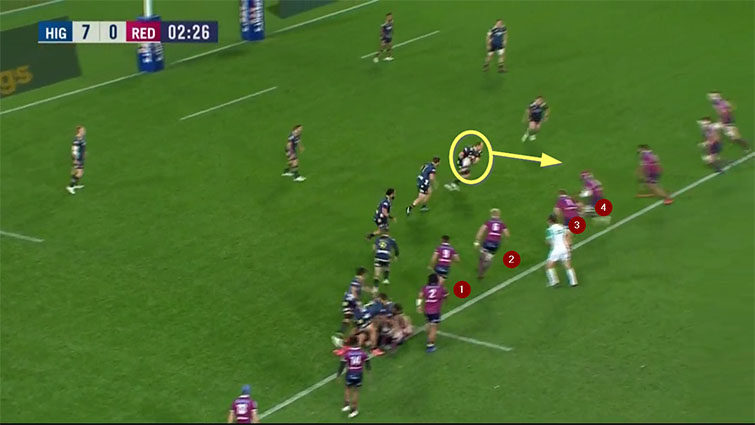
He can hit the far man of the forward pod outside him, and engage the fourth defender out from the ruck with the length of his delivery. He does not sacrifice any speed to get the ball to him. The pass flies out true and flat. This became an important factor in the Clan attacks later in the game.
On the next occasion, Smith used the success of the previous exit to set up a neat attack on the short-side guard closest to the ruck, from the same position in midfield:
He gives his number eight Kazuki Himeno a subtle wink as the ruck processes, and Himeno switches from left to right to overload Angus Scott-Young. Suddenly, the Landers are up to halfway with a minimum of risk.
Smith has TCUP in spades. Even when the Highlanders won a turnover penalty in the shadow of their own posts in the second half, he was already two steps ahead of everyone else and looking for the easiest exit from the 22 – even if it meant making a long pass off his left hand to find the space:
Smith signals out to the right before tapping the ball as Queensland forwards are still talking to the referee, and again the Reds find themselves back on the wrong side of halfway.
‘Nugget’ has always been one of the savviest number nines in his management of those vital situations around the base of the ruck. ‘Cleaning base’ means the ability to force a decision out of the referee when defenders are getting in the way on the wrong side:
Hamish Stewart (in the white headgear) does not do a lot wrong in the first example, but Smith milks the penalty by not offering to play a loose ball placement by Pari Pari Parkinson. In the second, he makes sure he collides with Scott-Young as the Reds number six gets up clumsily from the tackle.
But it was Smith’s ability to engage the fourth defender through the extra length and accuracy of his pass, even off his left hand, that was the critical factor:
The first notable looseness in line spacing occurs between the fourth and fifth Queensland defenders, and Smith can get the ball into that space with one action:
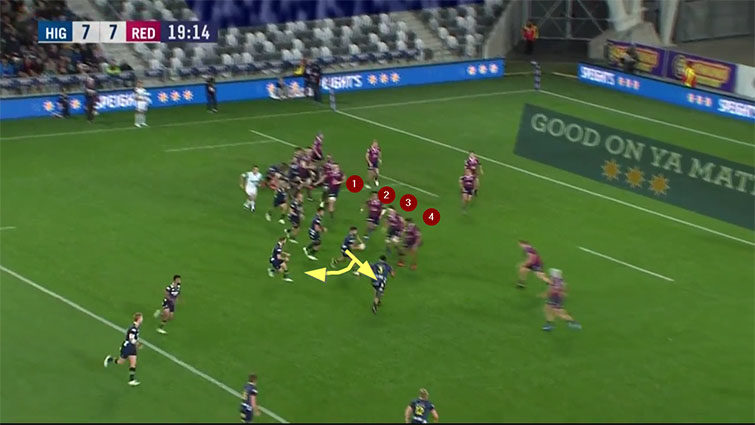
There are two nice options for the far man in the forward pod when he receives the ball – short to Siate Tokolahi, or out the back to Mitch Hunt.
The third Highlanders try of the game was all about Smith.
He forces the first Reds back, Jock Campbell, to plant by running around the base, then unleashes a pass off his left hand which consumes the last two defenders, Filipo Daugunu and Bryce Hegarty, in the first ruck:
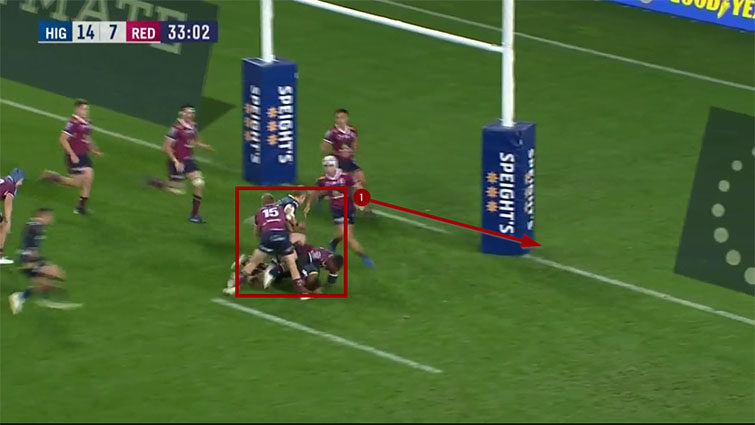
One pass has taken out the whole of the front line, and there is still half the field to work with on the next phase as Stewart wraps around the ruck desperately in cover. There is no prospect of him reaching Sio Tomkinson on the end of another terrific 25-metre bullet from Smith.
It is safe to say that no other scrumhalf in Super AU, or perhaps on the face of the planet, could have produced those two deliveries off the left hand in swift succession.
The Queensland defence found itself stressed in ways entirely unfamiliar from the domestic competition:
Smith takes a step out to engage the inside defenders, then hits the far man in the forward pod, Himeno, again. That mini-break sets up an easy run-in on the following play:
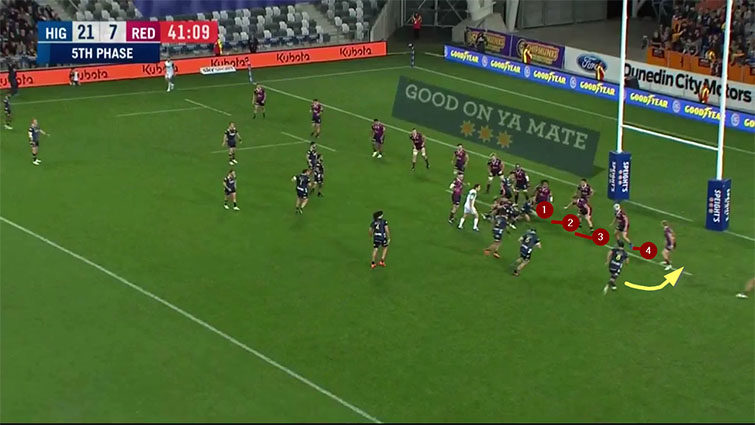
Summary
It was a virtuoso display from Aaron Smith, the golden nugget in the world of TCUP. The Queensland Reds would have seen nothing like him in Super Rugby AU, and they struggled to adjust to the speed of pass, and the speed of thought from the base.
Despite the short six-day turnaround and squad rotation which left starters on the sideline, it is never pleasant to be beaten out of a game so conclusively. That will have come as a big culture shock to the Reds players.
Without a top-notch kicking game off nine, they were generally forced to exit from further back, and that strategy was dragged into question by the quality of the Highlanders’ kick returns.
The Reds found themselves trying to play out from their own last third of the field, or defend desperate situations close to the goal-line far too often for comfort. That is what sudden changes of tempo, and the extra speed in thought and deed provided by players like Aaron Smith, can do to you.
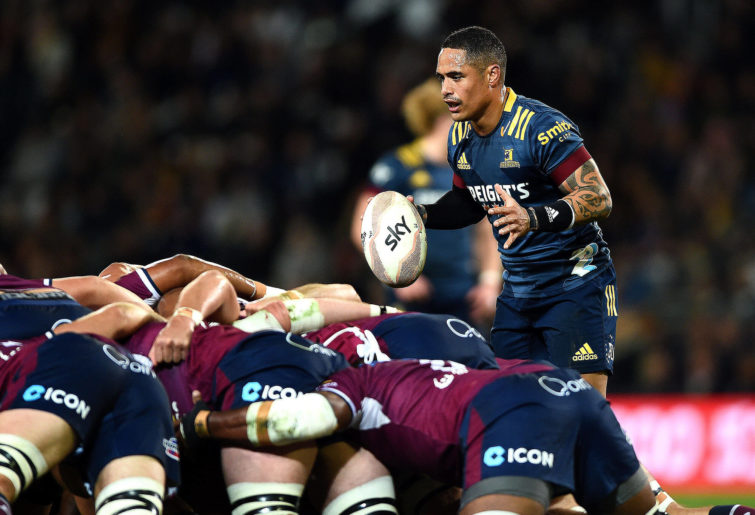
Aaron Smith. (Photo by Joe Allison/Getty Images)
It is no coincidence that the Australian teams who came closest to winning in the first round of Trans-Tasman games – the Brumbies and the Force – also boasted the two highest average times of possession during Super Rugby AU. They are both more structured than the Reds in their approach, and know how to keep the ball when they get it. That helps in any battle with teams from New Zealand.
It is not going to get any easier for the Reds, with the mighty Crusaders up next at Suncorp Stadium. This is rugby life at the next level, and they have to prove they can breathe in that more rarefied atmosphere.
Original source: https://www.theroar.com.au/2021/05/19/why-the-queensland-reds-hit-a-speed-bump-in-dunedin/
https://therugbystore.com.au/why-the-queensland-reds-hit-a-speed-bump-in-dunedin/
No comments:
Post a Comment